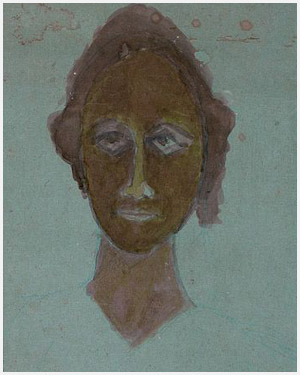EDUCATION
1866 Rabindradranath started learning basic alphabets
along with his brothers. 1868 He was admitted to the
Oriental Seminary and subsequently to normal school.
1870 Started learning drawing and music along with other
subjects and practiced wrestling and gymnastics. 1871
Was admitted to the Bengal Academy, an Anglo-Indian
School. 1878 Went to Ahmedabad to study English. In
the same he went to School at Brighton. 1879 Went to
England and was admitted to University College.
EXHIBITIONS
1930 May-Dec., First traveling exhibition, Gaierie
Pigalle, Paris. June, City Art Gallery, Birmingham,
U.K. June, India Society, London, U.K. July, Moeller`s
Gallery, Berlin, Germany. July, Art Club of Saxony,
Dresden, Germany. July, Gallery Caspari, Munich, Germany.
August, Charlottenburg Picture Gallery, Copenhagen,
Denmark. August, Geneva, Switzerland. September, State
Moscow Museum of New Western Art, U.S.S.R. October,
Doll and Richards Gallery Boston, U.S.A.; Museum of
Fine Arts, Boston, U.S.A. December, Fifty-sixth Street
Galleries, NewYork, U.S.A. 1931 Exhb. at the Newman
Galleries, Philadelphhia, U.S.A. 1931 Exhb. at Town
Hall, Bombay, India. 1932 Exhb. at Government School
of Art, Calcutta, India. 1933 Exhb. at Town Hall, Bombay.
1934 Exhb. at Colombo, Ceylon. 1934 Exhb. at Congress
House, Madras. 1938 Caiman Gallery, London, U.K. 1939
Bangiya Sahitya Parisad, Calcutta. 1943 Tagore Society,
Prince of Wales Museum, Bombay. 1943 Exhb. at Kala Bhavan,
Santiniketan.
COLLECTION
Indian Museum, Kolkata. National Gallery of Modern
Art, New Delhi. Rabindra-Sadana (Tagore Museum), Santiniketan.
Victoria and Albert Museum, London. Rabindra Bharati
University Museum, Kolkata. Delhi Art Gallery, New Delhi.
AWARDS
1914 Awarded the Nobel Prize for his literary achievements.
1915 Knighted by King George, but he rejected it.
STYLE
The purpose of art was for him self-expression or
more precisely `the expression of personality` and by
personality he meant the intimate and mutually transforming
dialogue between individual man and the word. During
the 40s paintings inspired by specific locations began
to grow in number and occupy a special place in his
oeuvre. On the one hand they carry forward a development
that began with his Santiniketan landscapes of the 30s
but on the other they also show a new departure. Panoramic,
and usually in ink on paper, they convey an experience
of space that is different from those of his earlier
landscapes. His last suit of drawings were done in the
early 60s, these show him moving further towards abstraction
and an extreme simply of statement.
TEACHING EXPERIENCE
Taught at Brahmacharya Ashram, Santiniketan.

back |



